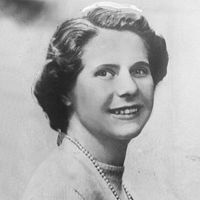
Joan Woodhouse
At about 5.20pm on Tuesday 10th August 1948, a 24 year old labourer/decorator called Thomas Stillwell walked into Arundel Police Station. He reported to officers he had found the body of a young woman. The Police visited the scene, a place known as Box Copse, a fairly secluded area in Arundel Park in the grounds of the imposing Arundel Castle in West Sussex.
The body was partially clothed, her outer clothing folded neatly, her handbag and a soft drinks bottle were found a few yards away. But who was she?

Joan Woodhouse
Joan Mary Woodhouse was born on 17th July 1921 to John Woodhouse and his wife Nellie (nee Wilkinson). They lived in Barnsley. Nellie came from a large working- class family, amongst her siblings were Annie and Ida. The former married Adam Blades in 1916. He was a Lance Corporal in the Yorkshire and Lancashire Regiment. Sadly, he was killed in action the following year. The latter, Ida, married Arthur Sheriff, the son of a shrimp dealer from Hull. In 1918 when he was just 26 years of age, he died in the Spanish influenza pandemic. Both Annie and Ida were widowed at a young age, neither remarried and neither bore any children. So, when Joan came along, it was her aunts, Annie and Ida, as well as her parents, that doted on her.
Nellie died of cancer in 1943. The bond between the young woman and her aunts, who she called Nan and Nida, was as strong as ever and they took it upon themselves to look out for their younger sister’s daughter. The aunts lived together at Astoria Court, Albion Terrace in Bridlington in the East Riding of Yorkshire.
Joan attended Barnsley Girls High School from 1933-1939, she took evening lessons in French, German, Literature and shorthand. In the early years of World War II (1939-41) she was an assistant at the Barnsley Municipal Library and 1941-42 at a branch of the West Riding County Library. She was called up for National Service in 1942 and worked for a year as a draughtswoman. This work she carried out in Sheffield and it was here she met Lena Bamber, (born 15th February 1922). Joan and Lena became firm friends. After a year of National Service, Joan was released to assist her parents who ran a residential youth club, her mother was an invalid at this time.
Joan went on to study librarianship at the University of London, Bloomsbury, London and thereafter she secured a job at the National Library which was part of the British Museum. After moving out of lodgings, she lived in an apartment on Baker Street. She was a sociable sort enjoying music, books and films. She was very active within the Anglican Church and gave herself a strict ‘Rules for Life’ agenda which included meditation, regular communion and confession, reading the Bible and basically living a respectable and religious lifestyle.
In December 1947 John Woodhouse remarried, his new bride was Hilda Coldell, a woman many years his junior, in fact she was a similar age to Joan. Joan was in a relationship of her own, she was courting Ted Roberts, also a librarian. The Woodhouse family believed Ted could not compete with Joan’s strict religious beliefs and he ended the relationship, but by Ted’s own words, they grew apart. The breakup of their relationship was devastating for Joan. In March 1948 Joan suffered what was described as a ‘nervous debility’ and went to stay with her aunts to recuperate. Joan resigned from her job as librarian in late April 1948. Whilst staying with the aunts, she confided in them and confessed to a half-hearted suicide attempt when she took aspirin. The aunts were very worried about Joan’s actions and concerned for her well-being. After a few weeks she appeared to show some signs of a recovery and was urged to busy herself in work. In May 1948, Joan wrote to the Secretary of the Trustees at the library where she had previously worked and asked if she could withdraw her resignation, this was allowed and she returned to London and to work. The aunts advised her to move out of her Baker Street address and go to live somewhere she would have company. Clearly, the advice was to distract Joan from the relationship breakup and any melancholy she had been experiencing.
After a short stay at Ashley House, Endsleigh Gardens, Joan moved to the YWCA hostel, 29 Bennett Park, Blackheath, SE London. The residents shared rooms and occupied communal spaces and the aunts believed this would help Joan through a difficult personal time.
Nicole Ashby shared a room with Joan. According to Nicole’s recollection when she gave a statement to the police, at 8.30am on Saturday 31st July 1948 Joan told her she was leaving to take the 1010 train from Kings Cross to Barnsley to visit her family. It was a hot summer and the first weekend of the month was the August Bank Holiday that year. London was very busy the Summer Olympics had started in the city the previous Thursday (the Games finished on Saturday, 14th August, they were the first Olympic Games since the 1936 Berlin Games prior to the onset of World War II). Before leaving the hostel, Joan wrote her name on the board, the requisite action for requesting an evening meal on the Tuesday after the Bank Holiday, she clearly intended to be back at the hostel. When Joan left the hostel, she was wearing blue sandals, blue lace gloves and a very distinctive multi-coloured paisley dress. She carried a blue weekend case and a handbag, she had with her a coat and a mackintosh.
However, rather than travelling North from Kings Cross, she travelled from Victoria Railway Station to Worthing on the South Coast of England, where she deposited her small blue hand case in the left luggage locker. On lodging the case she made her way by bus from Worthing to Arundel.
Over the years this story about the intended trip to Barnsley to visit family was repeated time and again. A story we later examined in the documents in the Records Office.
Joan knew the West Sussex area quite well. Her aunts had lived in Worthing and they had enjoyed picnics in Arundel Park when she spent holidays with them. Joan was seen that Saturday afternoon by a number of witnesses in Arundel, amongst them the Chemist, Mr. Bowles, who sold her a bottle of lemon barley drink, after all it was a very hot summers day. Another, Miss Dibley, recalled visiting friends in Arundel Square and seeing a young woman wearing a very striking dress in the street.
On the Wednesday after the Bank Holiday weekend, the hostel was contacted by a member of staff at the University Central Library where Joan worked, was she ill? she hadn’t attended work after the weekend. On the Thursday a telegram arrived at the hostel addressed to Joan. The hostel warden opened it, it was from John Woodhouse and it stated, ‘Are you OK. If not come home. Auntie is worried’ Now the warden was very worried, she sent a telegram to John Woodhouse to say that Joan had gone away for the weekend and she had not returned. The warden went to Lee Road Police Station and reported Joan missing. The warden wrote a letter to John Woodhouse, the letter arrived on the Friday morning and by 9am the following day, John Woodhouse and his sister- in- law, Ida Sheriff, were on the doorstep of the hostel. They believed the attempted suicide was the key to Joan’s disappearance and feared she had gone off to take her own life. They returned home that day taking with them all of Joan’s belongings from the hostel. Then they waited, Sunday, Monday, Tuesday with no word from Joan or any information of her whereabouts.
The grim discovery was made by Thomas Philip George Stillwell. Joan was partially clothed wearing a bra, camiknickers, a suspender belt securely attached to her stockings and sandals. It is reported her outer clothing was folded neatly in a pile a few feet away. There appeared to be no signs of a struggle, save for some scuff marks on the trees near the body (had the attacker or attacked tried to gain purchase as the assault took place). Joan had bruising on the inside of her thighs conducive with a forced sexual act. It was believed that her nose and mouth had been covered and then she had suffered manual strangulation. Joan had been raped and murdered.
The local Police called in New Scotland Yard and Chief Inspector Fred Narborough, as was his rank at the time, commenced the first police investigation. The investigation is catalogued in the book he wrote after his retirement entitled, ‘Murder on My Mind’ published in 1959.
A ticket was found amongst Joan’s effects. It was a ticket for the left luggage at Worthing station. Recovered from the station was the weekend case and its contents.
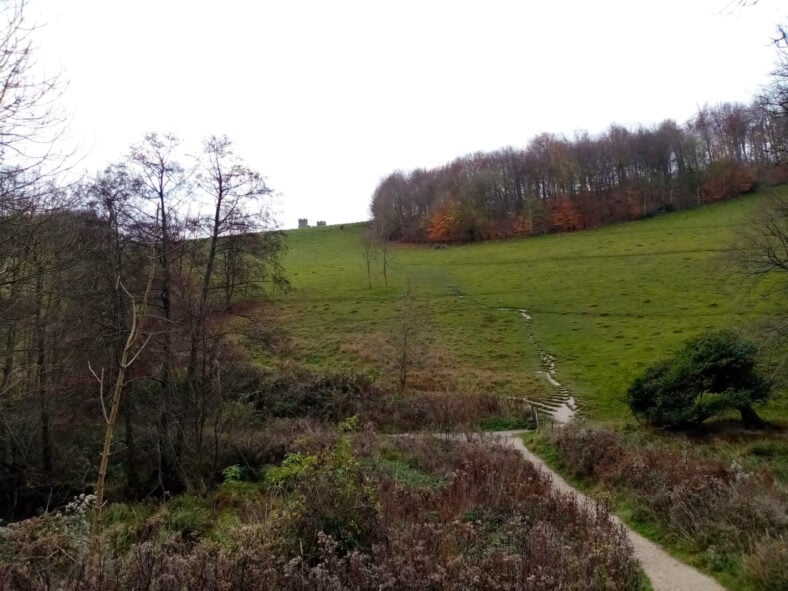
Box Copse woodland in Arundel Park, where Joan's body was discovered. Taken from our own visit to the area in 2021
The line of enquiry Narborough pursued initially was based on a book that was found in Joan’s belongings. It contained in the region of a hundred men’s names and details. He also considered the comments of the pathologist who conducted the post mortem, Dr Keith Simpson, who suggested that the folding of the outer garments may be indicative she had removed them herself or allowed them to be removed. This suggested, Joan had consented to the removal of her outer clothing, perhaps in the company of another. The family vehemently opposed this approach; Joan was a good girl, religious and very committed to her faith. It’s not always beneficial to rely on a family’s portrait of their loved ones so the police enquiry and its enquiries had to be based on their findings and not what was reported by those closest to Joan. As a result, Narborough pursued this line of enquiry. He had each one of the men, whose name appeared in Joan’s book, traced and interviewed. It became apparent that rather than these being social contacts or potential boyfriends they were all members of a student/librarian society in which Joan had an administrative role.
In September 1948, Fred Narborough and the officers working the enquiry, had a review of the case. The day after the review, he invited the family to London to discuss the investigation, little progress had been made despite many man hours being expended in the course of the enquiry. Not wishing to miss anything of Joan’s life out of the investigation into her death, Narborough asked the family members who were present, to tell him everything about Joan. They talked about Joan, her home life, her education, her faith, her likes and dislikes.
Lots of the information given was known to the police already until Ida Sheriff mentioned Joan loved to sunbathe and at the first sign of the sun, she would remove her outing clothing and lay down to enjoy the warmth of the day. This was a revelation for Narborough and his officers, it may be that Joan had removed her clothing but not for a consensual sexual act but to merely sunbathe and hence the clothing was neatly folded. Narborough was aghast at the comments. The perpetrator had the advantage of not just 10 days, whilst the body remained undiscovered, but a further 6 weeks in which the police were prioritising the book and the men’s names within it. Narborough makes mention in his book of the ‘wasted time’. The Police needed to look elsewhere for answers.
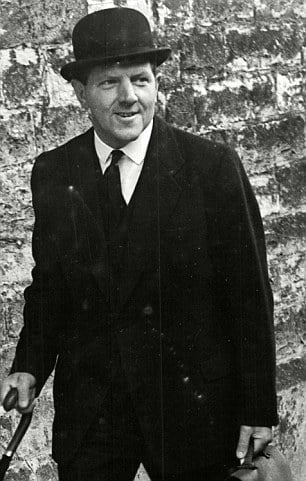
Fred Narborough
In 1948, Stillwell was 24 years old. He was a painter in the locality and lived with his parents, Thomas and Ellen, his brothers Arthur and Philip and his maternal grandfather, George Parsons. The family resided in a remote house on the Duke of
Norfolk’s estate, it was called Foxes Oven. Its position is somewhat secluded and probably a difficult place to live because of its isolation back in the 1940’s.
Thomas Snr, was many years older than Ellen. He was described as an ex- navy man and a heavy drinker. It is said that in her early years, Ellen worked in service at Arundel castle. The 15th Duke of Norfolk died in 1917 and was succeeded by his eldest son, Bernard Marmaduke Fitzalan-Howard, who was only 9 years old at the time. It was alleged by locals that young Thomas Stillwell was the illegitimate son of the 16th Duke. This has remained the subject of rumour and speculation ever since but has not been evidenced.
Thomas Jnr, was known as a ‘Peeping Tom’ and an ‘oddball’. His stomping ground was Arundel Park where he followed young girls and women for his own pleasure. There were allegations of him exposing himself to females, but no evidence found in research that he had any previous convictions.
Thomas and his family were regulars at The Black Rabbit Public House. At the time of the murder the landlord was Mr Knight and he lived at the public house with his wife, daughter and son in law, Frederick Chamberlain. Thomas played darts at the pub and carried his own pack of darts in his top breast pocket as a matter of course. A dart was found near Joan’s body. Thomas later asked the police if they had found a dart because he was missing one. The finding of the dart also became the subject of speculation. The rumour mill started that if the dart found near Joan’s body was Stillwell’s lost dart, he must have been the one who attacked and killed Joan. But as the finder of the body, he explained away the presence of the dart. It was a legitimate explanation.
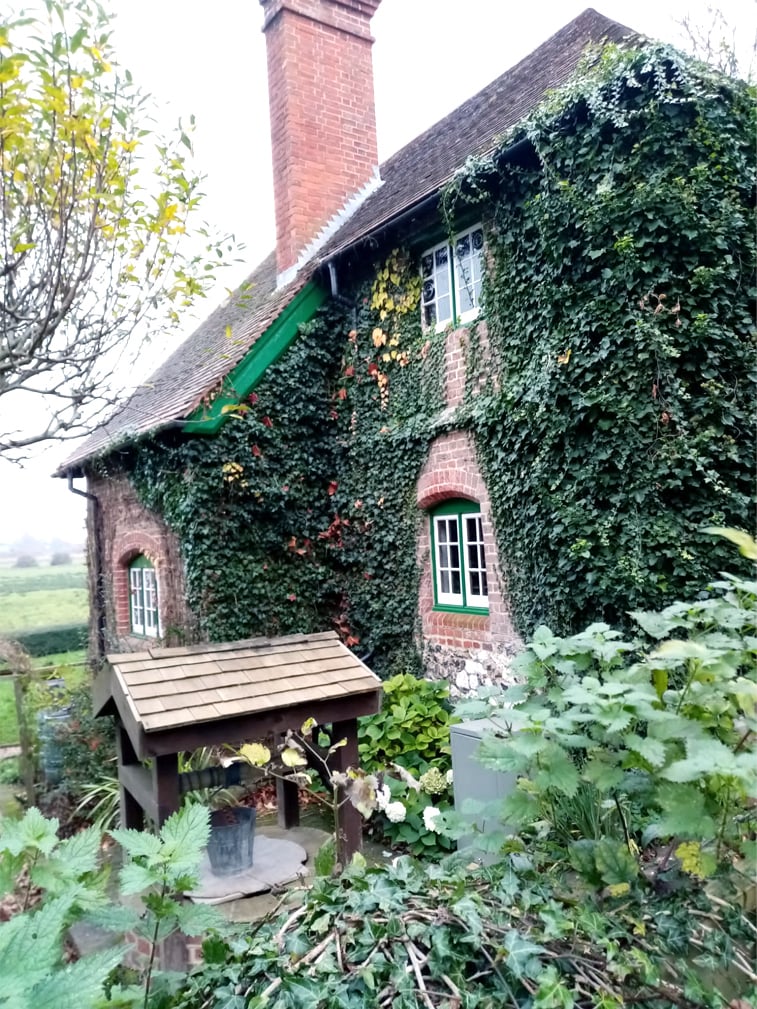
Foxes Oven, taken on our visit in 2021
In those early days, Fred Narborough directed his officers to carry out other lines of enquiry as well as tracing the men whose names were in Joan’s book. They located Ted Roberts and interviewed him. He had a solid alibi for the Bank Holiday weekend and was ruled out of the enquiry. The Police interviewed and took statements from witnesses who knew Joan or had seen or thought they saw Joan on her journey that Saturday. In fact, they had ‘sightings’ of Joan the length and breadth of the country.
Narborough, in his book, describes putting in motion the biggest door to door hunt of post war years. Every guest house, hotel or apartment accommodation in Worthing was visited by officers armed with a photograph of Joan. Had they seen Joan, did she visit their establishments? Did she book accommodation? Was she alone? Narborough’s officers also obtained the names and addresses of every unattached male who had stayed in Worthing at the time of the murder. No useful information was forthcoming and so the attention switched to Arundel and the surrounding villages. The same enquiries were made and similar questions asked. Every holiday maker in Worthing and Arundel on Saturday 31st July 1948, was traced, visited and interviewed by police officers, the photograph of Joan was showed to them. British Rail employees at Victoria, Worthing and Arundel were interviewed. The drivers and the conductors on the buses and coaches that operated between London and the south coast were all seen and interviewed. Taxi-drivers in the area were also tracked down and spoken to. In Arundel every male over the age of fifteen years was questioned and requested to account for their movements on that Saturday. The investigation was undoubtedly, thorough.
VIDEO: Box Copse in 2021
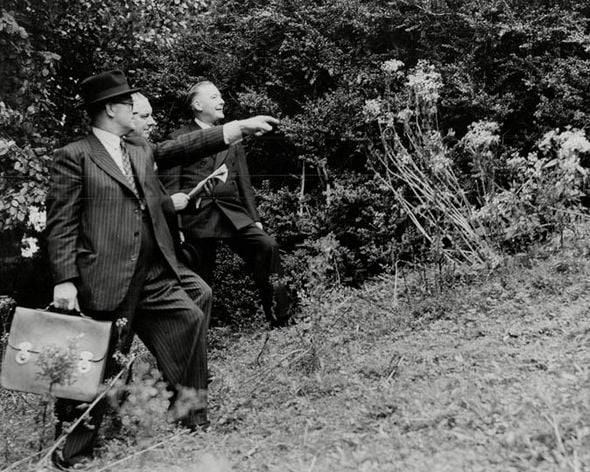
The Police Searching For Clues In Arundel Park
Attention had turned to the ‘finder’ of Joan’s decomposing body, Thomas Stillwell. The evidence that pointed to Stillwell was circumstantial and no direct evidence could be secured. One of the main difficulties was connecting Joan with Stillwell at or near the time of her death. As the body had lain for, according to Dr Simpson, some 8 to 10 days, it wasn’t possible to pinpoint the actual day she had died let alone the time. It was believed death occurred that Saturday when she travelled to the south east. If there was no time then there was no way to connect these two individuals. Thomas Stillwell admitted being a regular to Arundel Park. One of his darts was found at the scene, but Stillwell had found the body, it could have dropped from his pocket when he found Joan, it was dry and unrusted, suggesting it had not lain in the open air at the scene and was dropped on the day the body was found.
Witnesses had seen Stillwell in and around the park over that weekend but that added nothing. His clothing had been laundered which was not surprising given that it was some weeks since the Bank Holiday weekend. The fact that Stillwell was known as a ‘Peeping Tom’ was a reason for suspicion. He was known to follow girls and women and make lewd suggestions or expose himself but that didn’t make him a murderer.
As the investigation ran out of steam, it was concluded there was insufficient evidence to take any action against Thomas Stillwell, although Narborough believed, by the end of his investigation, that Stillwell was his man.
John Woodhouse and the family were told there was insufficient evidence to bring any charges against Stillwell. The family were deeply upset. And so began their campaign to bring Thomas Stillwell before the courts and pursue justice for Joan.
It was decided by the family to hire a private investigator to make enquiries into Joan’s death. The man charged with that enquiry was Thomas Jacks. He was a retired policeman from the Yorkshire Constabulary. He appeared to have little or no experience in investigating serious crime. In those days, provincial police forces could call on New Scotland Yard to provide officers to take charge of serious crime investigations. They could provide local officers with the benefit of experience. New Scotland Yard officers were used to dealing with serious crime as a matter of course and their investigative skills and expertise were welcomed by those less bothered by frequent, shocking and horrific crimes.
Thomas Jacks was assisted by another ex- police officer from Birmingham by the name of Ballard. They conducted their enquiries in and around the Arundel area in October 1949. But a lot of what they gathered was rumour and gossip or what one witness described as ‘pub talk’.
Over the next months, the family instructed a barrister to give an opinion about the merits of taking action against Stillwell. The conclusion was, there was sufficient evidence to bring criminal proceedings against Stillwell. The barrister was given information in the form of Thomas Jack’s report, so it’s little wonder he came to the same conclusions as Jacks.
As a result of Jack’s report, the case was reinvestigated by another New Scotland Yard detective, Reginald Spooner. A man of many years’ experience and a well- respected member of the Yard. Fred Narborough had retired by this time and so it was a fresh pair of eyes that came to the case. There were suggestions that Narborough had been ‘sacked’ because of his failure to bring any person to justice for the killing of Joan Woodhouse. This appears not to be the case. When Spooner completes his report after his thorough reinvestigation, he refers to Fred Narborough as ‘ex Superintendent’. Narborough was Chief Inspector when he was in charge of the initial murder enquiry. It would appear that rather than be sacked, he was promoted to a higher rank after his involvement in the Woodhouse murder and then he retired, a fact mentioned in Narborough’s own book.
After the re-investigation by Spooner, the same conclusion was reached, the main suspect was Thomas Stillwell but there was insufficient evidence to commence criminal proceedings.
An eminent criminal barrister compiled his opinion into the matter on behalf of the Police and considered whether there was sufficient evidence to take any action against any individual, notably, Thomas Stillwell. He concluded there was insufficient evidence to arrest Stillwell let alone pursue any action against him. Once again, the family were informed that there was insufficient evidence to proceed.
The Woodhouse family would not accept these findings and sought a private prosecution against Thomas Stillwell. As a result, a warrant was issued for Stillwell’s arrest on 30th August 1950. He was arrested later the same day and remanded in custody at Brixton Prison until the committal stage of the proceedings some weeks later. On 19th September 1950, the committal commenced in front of five magistrates in the Town Hall at Arundel. The court heard evidence from witnesses and the magistrates had to determine if there was sufficient evidence to commit the case to the Crown Court where a full trial could be heard. On 22nd September 1950, the magistrates made their decision, there was insufficient evidence to commit Stillwell to trial and he was released a free man.
Once again, the family were angry and upset at the findings of the magistrates. They continued their campaign to bring justice for Joan. The main protagonists were the aunts, most notably, Ida Sheriff and also Joan’s very good friend, who she had met during the war years in Sheffield, Lena Bamber. They wrote to the Director of Public Prosecutions, Members of Parliament, the police and many others, who they believed could bring the matter to some kind of resolution. The family instructed another barrister to give his opinion on the merits of taking out a Bill of Indictment against Stillwell for the murder of Joan. He came to the conclusion there were outstanding questions to be answered before such an application was made and the Director of Public Prosecutions should consider this.
It is clear from the documentation these ‘outstanding’ matters had already been investigated and evidenced. A Bill of Indictment was not granted. No person has ever been tried and convicted for offences regarding the death of Joan Woodhouse.
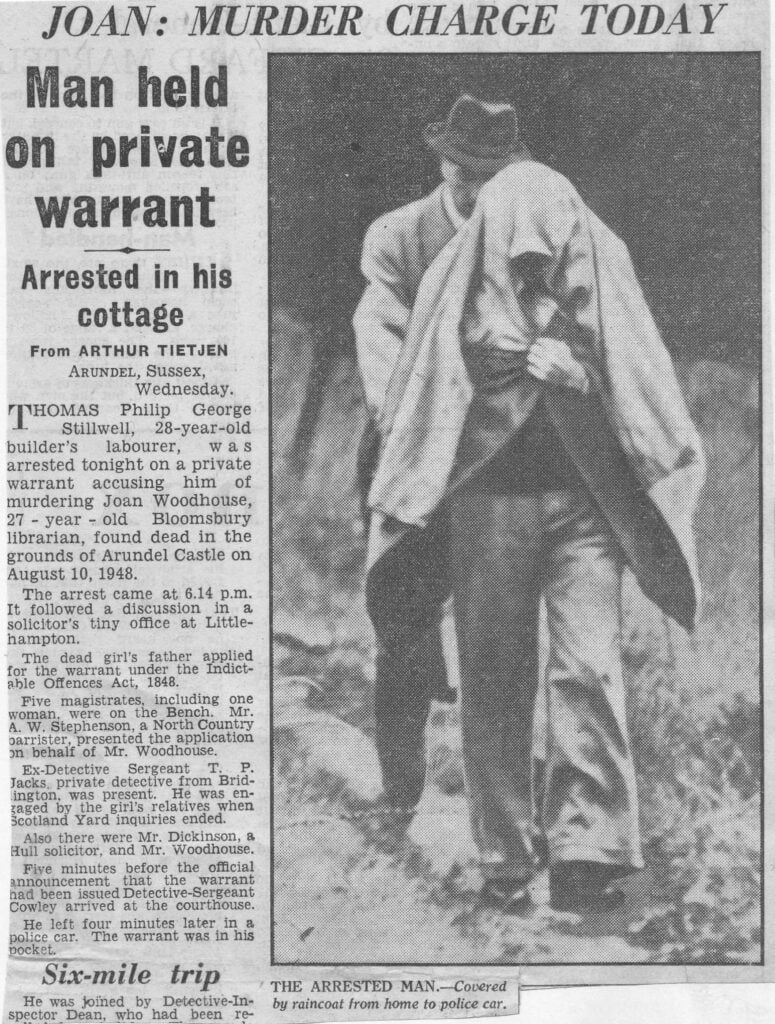
Newspaper clipping
As a young man in the 1970’s, Martin read a book by Professor Keith Simpson entitled ‘Forty Years of Murder’ he was fascinated by the chapter ‘Who Killed Joan Woodhouse’. Professor Simpson was the Home Office Pathologist who, then Dr Simpson, had carried out the post mortem on Joan Woodhouse. As Martin finished the book, although interested in the subject matter, he thought no more of it. Then many, many years later, Martin remembered the story of the murder of Joan Woodhouse, he entered Joan’s name into an internet search engine and what it revealed was a ‘thank you’ to the people of Arundel for remembering the 60th anniversary of Joan’s death. The thank you was penned by Lena Bamber, Joan’s very good friend. Martin decided to contact Lena. He visited her at her home in Heanor, Derbyshire. She was by then a very elderly lady. She was unmarried and a former primary school head teacher. She spoke to Martin about her regret at not being able to do anything that would bring a conclusion to Joan’s case. In the latter years she spoke to her family about Joan and the ‘failed’ investigation. As Liz Willetts, Lena’s niece recalls, Lena kept a photograph of Joan in the hallway of her home. Joan was very much part of Lena’s story.
Martin published his book in 2016, sadly Lena did not live to see the release of the book. However, Martin had provided her with his manuscript prior to publication. Martin says with a heavy heart, Lena, had passed on the cobwebbed baton that was the Joan Woodhouse murder enquiry to him.
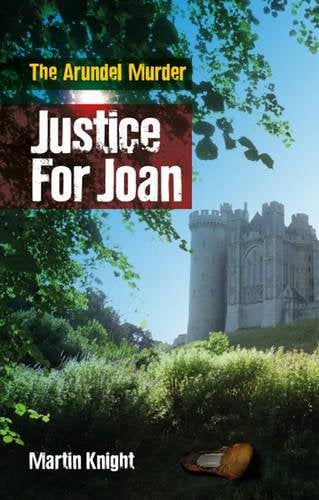
True Crime Investigators UK, were contacted by Martin to review this outstanding case and we carried out many days, weeks and months of research. We visited the relevant sites in and around Arundel Park. In the main, we did not adopt anyone else’s research but went in search of information from the time of the murder. We looked at what had been said and reported and asked the question, ‘how do we know that’ and went in search of the answers. What we uncovered shocked us. The story of the ‘failed’ investigation, the incompetence of the senior police officers involved and their abject failure to bring Thomas Stillwell before the criminal court, was indeed that, it was a story, a story that had been repeated through the years. The truth of the matter was, as far as we could see, both police investigations were thorough. Evidence that had been ‘lost’ so the story went, was accounted for in the documentation we examined, the sacking of Narborough because of his failure in the Woodhouse case, was found not to be the case, he had been promoted after this investigation and then retired.
The story of the murder case as it was reported over 70 years and the uncovering of evidence to the contrary was not difficult to find. It was time consuming and laborious but it was all there. Tribute should be paid to the memories of Fred Narborough and Reginald Spooner for their tenacity and professionalism. Despite being unable to bring the perpetrator of Joan’s murder to the criminal courts, they tried their very hardest to bring justice for Joan.
We know that it is very difficult for those who knew and loved Joan to accept an unsatisfactory outcome. The baton of ‘Justice for Joan’ is now in our hands and we will continue with our re-investigation.
See the contents of the Briefcase by [CLICKING HERE]
Free AI Website Software